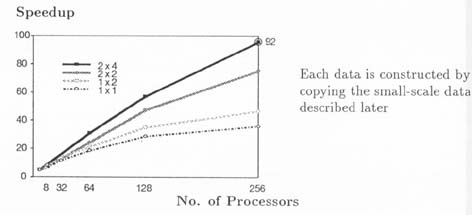
Speedup
process that crosses it. Here the expected points is defined as the closest point to target point T of all points on each line process. When all answers have arrived at the requesting line process, the line pro- cess found to be closest to the target point is selected. Then, S and the intersection point of the two line processes are connected. Next, a request message (route message) for searching paths is thrown to the line process, which returned the closest point to the target point. Finally, the routing process is completed when the expected point is equal to the target point. PROCESS STRUCTURE FOR LARGE-SCALE DATA The designing of routing programs based on a concurrent objects model requires many communication paths between processors. So, a lot of memory is consumed in controlling them. To solve this problem, we assign a distrib- utor process to each processor to reduce the number of communication paths between processors. PARALLEL SPEEDUP
 Speedup |